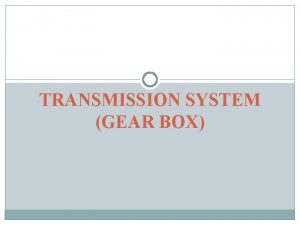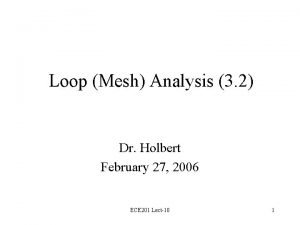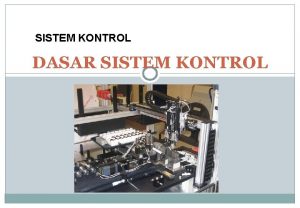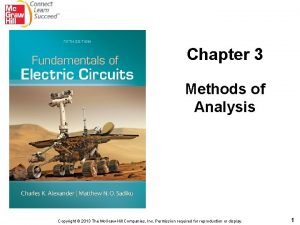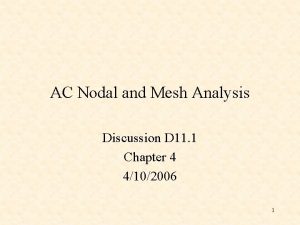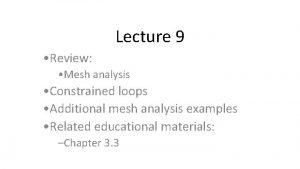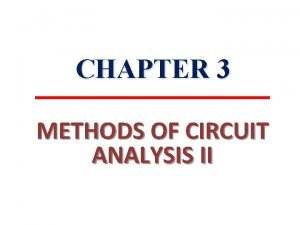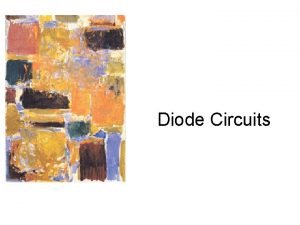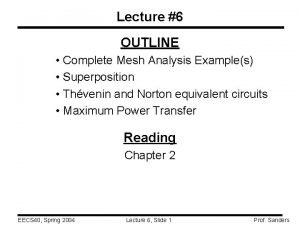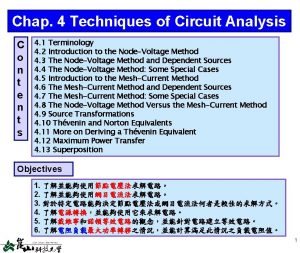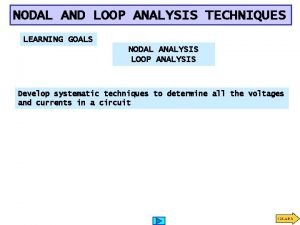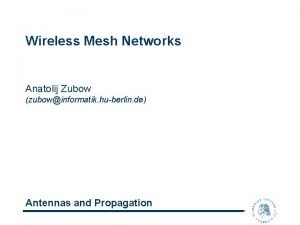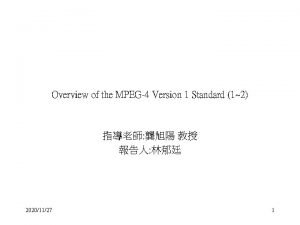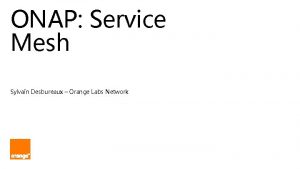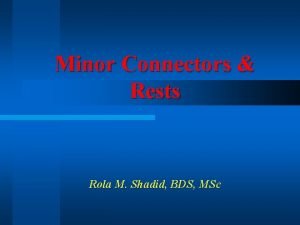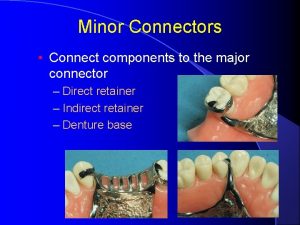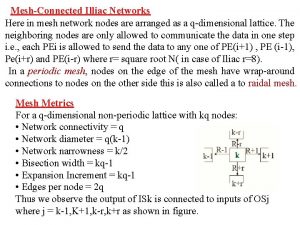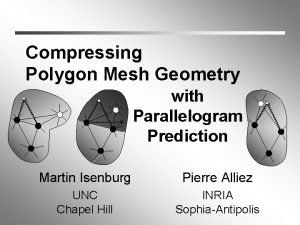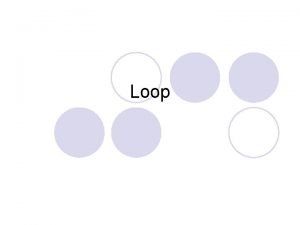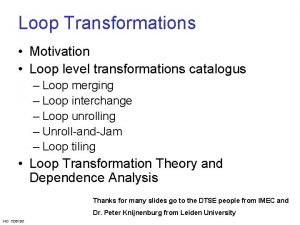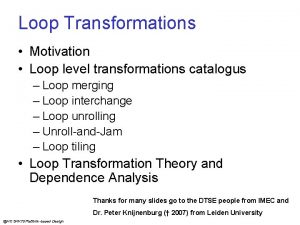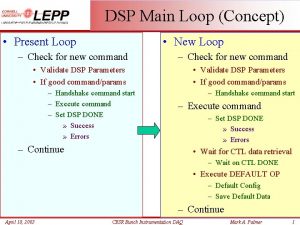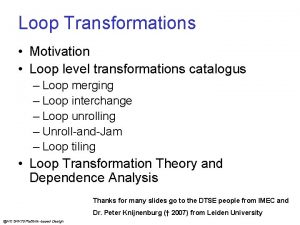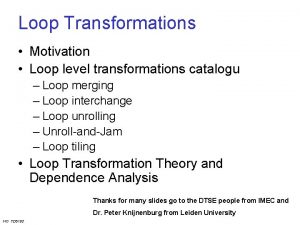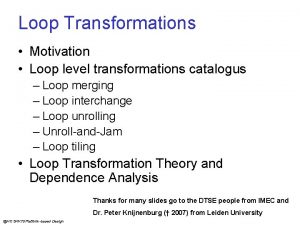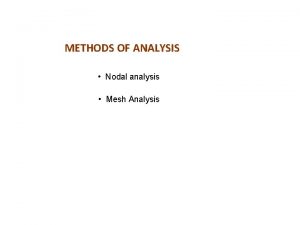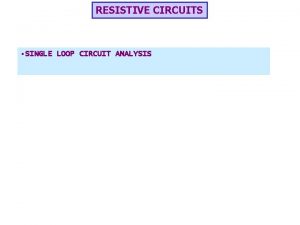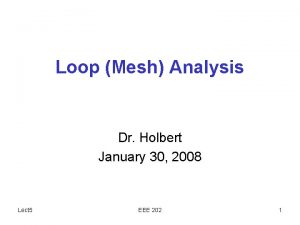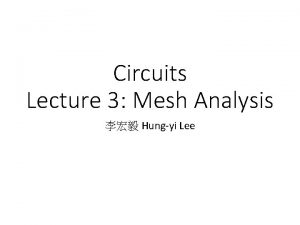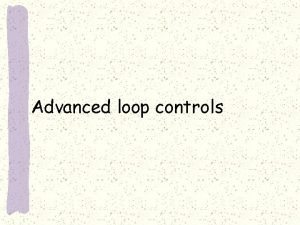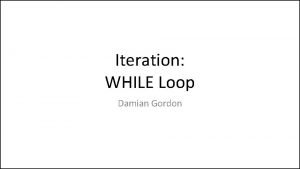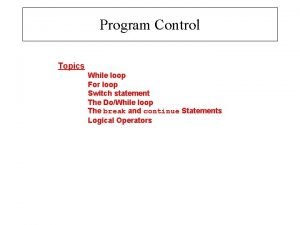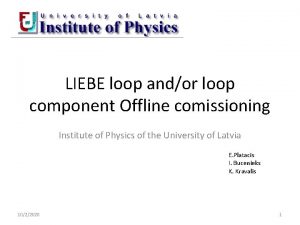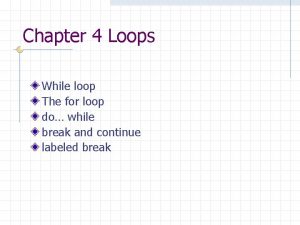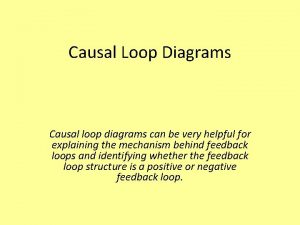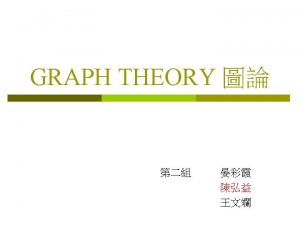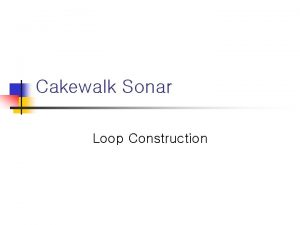Mesh Analysis Mesh Analysis Loop Analysis Mesh A
































- Slides: 32

Mesh Analysis

Mesh Analysis (Loop Analysis) Mesh = A closed loop path which has no smaller loops inside

Mesh currents are circular currents used for calculation. Mesh currents are not real currents. I 1 I 2 Mesh current (loop current) Real current is a sum of all mesh currents passing through that point.

Mesh Analysis Procedure 1. Count the number of meshes. Let the number equal N. 2. Define mesh current on each mesh. Let the values be I 1, I 2, I 3, … 3. Use Kirchoff’s voltage law (KVL) on each mesh, generating N equations 4. Solve the equations

Example Use mesh analysis to find the power consumption in the resistor 3 Ω I 1 I 2 Mesh current (loop current)

I 1 I 2 Loop 1 Equation 1 Loop 2 Equation 2 I 1 = 6 A, I 2 = 4 A, The current that pass through R 3Ω is 6 -4 = 2 A (downward) Power = 12 W

Example Use Mesh analysis to find Vx I 2 I 1 I 3

I 2 Equation 1 I 3 Equation 2 Equation 3 I 1 = 3 A, I 2 = 2 A, I 3 = 3 A Vx = 3(I 3 -I 2) = 3 V

Supermesh When there is a current source in the mesh path, we cannot use KVL because we do not know the voltage across the current source. We have to use supermesh, which is a combination of 2 meshes to be a big mesh, and avoid the inclusion of the current source in the mesh path.

Example Use Mesh analysis to find Vx I 2 I 1 I 3

I 2 I 1 I 3 Equation from 2 nd loop

Supermesh I 2 I 1 I 3 Equation 2 Equation 3

I 1 = 9 A I 2 = 2. 5 A I 3 = 2 A Vx = 3(I 3 -I 2) = -1. 5 V

How to choose between Node and Mesh Analysis The hardest part in analyzing circuits is solving equations. Solving 3 or more equations can be time consuming. Normally, we will count the number of equations according to each method and select the method that have lesser equations.

Example From the previous example, if we want to use Nodal Analysis 7 V V 1 V 3 0 V V 2

Example: Dependent Source Find Vx I 2 I 1 I 3

Equation 1 I 2 I 1 Equation 2 I 3 Equation 4 I 1=15 A, I 2=11 A, I 3=17 A Vx = 3(17 -11) = 18 V

Special Techniques • Superposition Theorem • Thevenin’s Theorem • Norton’s Theorem • Source Transformation

Superposition Theorem In a linear circuit, we can calculate the value of current (or voltage) that is the result from each voltage source and current source independently. Then, the real value is the sum of all current (or voltage) from the sources.

Linearity V and I have linear relationship I V

Implementation When calculating the effect of a source, the other sources will be set to zero. • For voltage sources, when set as 0 V, it will be similar to short circuit • For current sources, when set as 0 A, it will be similar to open circuit

Example I 1 = 1 A I 2 = 2 A I total = 1+2 = 3 A

Example I 1 = 1 A I 2 = 0 A I total = 1+0 = 1 A

Example Find voltage Vx




Superposition and Dependent Source Dependent sources cannot be used with superposition. They have to be active all the time.

Example Use superposition to find Ix

Find Ix by eliminating the current source 3 A KVL

Find Ix by eliminating the voltage source 10 V Ix+3 KVL outer loop

 Sliding mesh vs constant mesh
Sliding mesh vs constant mesh Mesh analysis 3 loops
Mesh analysis 3 loops Diagram blok pemanggang roti
Diagram blok pemanggang roti Fifth gear loop the loop
Fifth gear loop the loop Open loop vs closed loop in cars
Open loop vs closed loop in cars Manakah yang lebih baik open loop atau close loop system
Manakah yang lebih baik open loop atau close loop system While do loop
While do loop Accidental whorl
Accidental whorl Multi loop pid controller regolatore pid multi loop
Multi loop pid controller regolatore pid multi loop Non planar circuit
Non planar circuit Find v
Find v Mesh analysis matrix method
Mesh analysis matrix method Ac nodal analysis
Ac nodal analysis Mesh analysis
Mesh analysis Non planar circuit
Non planar circuit Vt diode
Vt diode Mesh analysis examples
Mesh analysis examples Mesh current
Mesh current Nodal and loop analysis
Nodal and loop analysis Sky q mesh network diagram
Sky q mesh network diagram Star mesh
Star mesh Service mesh
Service mesh Verlife m tablet
Verlife m tablet Mpeg-4 mesh animation
Mpeg-4 mesh animation Maesh service mesh
Maesh service mesh Rest seat prep
Rest seat prep Lattice minor connector
Lattice minor connector Iskxxosj
Iskxxosj Arrow mesh wifi
Arrow mesh wifi Meshnet: mesh neural network for 3d shape representation
Meshnet: mesh neural network for 3d shape representation 11s mesh solutions
11s mesh solutions Mesh wifi handoff
Mesh wifi handoff Polygon predictions
Polygon predictions
